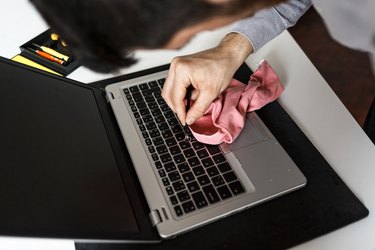
A computer keyboard is one of those things that most of us take for granted until it stops working. We eat and drink at our computers and don't think about the accumulated crumbs and grime until keyboard keys are sticking. You may not be able to salvage a keyboard that's had a cup of coffee spilled on it, but there are ways to safely clean a sticky keyboard and continue using it.
Keyboard Keys Sticking
Video of the Day
Before you start cleaning any computer peripheral like a keyboard or mouse, disconnect it from your computer. If you're cleaning the built-in keyboard on a laptop, power down the entire laptop. Now turn the keyboard over and gently shake it to remove food crumbs and other debris. Then use a can of compressed air, available in most office supply stores, to gently blow away any remaining dust and particles. A small vacuum will serve the same purpose. Tilt the keyboard slightly while spraying or vacuuming and rotate it to reach every angle.
Video of the Day
Now you're ready to address the surface of your keys. Some computer manufacturers recommend using a damp cloth made of microfiber to gently clean the keys, while others suggest cotton swabs dipped in isopropyl alcohol, also known as rubbing alcohol. Mild soap and water are also recommended for cleaning keys. While cleaning, it's important to make sure that liquid stays on the keys and does not spill onto the keyboard surface. If several different people use your keyboard and you're worried about germs, give your keys a final swipe with a disinfecting wipe.
Sticky Keys Caused by Software Issues
If you're having issues with what seems like a sticky keyboard on a Windows or Mac computer and cleaning doesn't help, make sure the Sticky Keys feature is turned off before searching for a software solution. This accessibility feature makes modifier keys like Ctrl remain active after they are pressed and released, allowing keyboard shortcuts to be executed by typing two keys sequentially instead of holding them down at the same time. On Windows, you can see if Sticky Keys are enabled in the Keyboard section in the Ease of Access panel, available from the Windows Control Panel. On a Mac, check the Keyboard tab under System Preferences.
In rare cases, a sticky key is caused by a problem with a computer's software. For example, if a laptop key acts stuck but is not stuck on the keyboard and nothing has been spilled on the keyboard, then a driver or other piece of operating system software could be the root of the problem. If you've cleaned your keyboard and still experience keys that aren't working correctly, check with your laptop vendor to find out if a driver update will fix the problem.
Sticky Keyboard Mac
Apple's butterfly keyboard, which is included with the MacBook (2015 and later) and MacBook Pro (2016 and later), is reported to have a tendency for sticky keys. The keyboard gets its name from the mechanism that attaches individual keys to the keyboard, which is thought to resemble a butterfly's wings. Apple Support recommends using compressed air to clean the keyboard while holding the Mac notebook at a 75-degree angle (just short of vertical). Spray with air, then rotate the notebook to its right side, spray, then rotate it to its left side and spray again. If keys are still sticky, visit an Apple Store or authorized service provider for further repairs.
Removing Sticky Keys for Cleaning
You may be tempted to remove keys on your keyboard if you think there's dirt underneath, but you could break your keyboard this way. Not all keys are removable and some require special tools. To avoid damaging your keyboard, check online for a user manual or instructional video for your specific model before attempting to remove the keys or keycaps.